A few months ago I read Alondra Nelson’s book titled The Social Life of DNA Race, Reparations and Reconciliation After the Genome. This post is inspired by that read. After I’d finished I realized that I had never quite spelled out the terms and pitfalls of my personal DNA quest and how I was going about it. And of course Nelson’s work presented ideas I’d never really considered, such as proving a genetic connection to Africa as a means of potentially receiving monetary reparations. If any restitution is to be made for what has occurred to my ancestors I have decided it will and must first come from me.
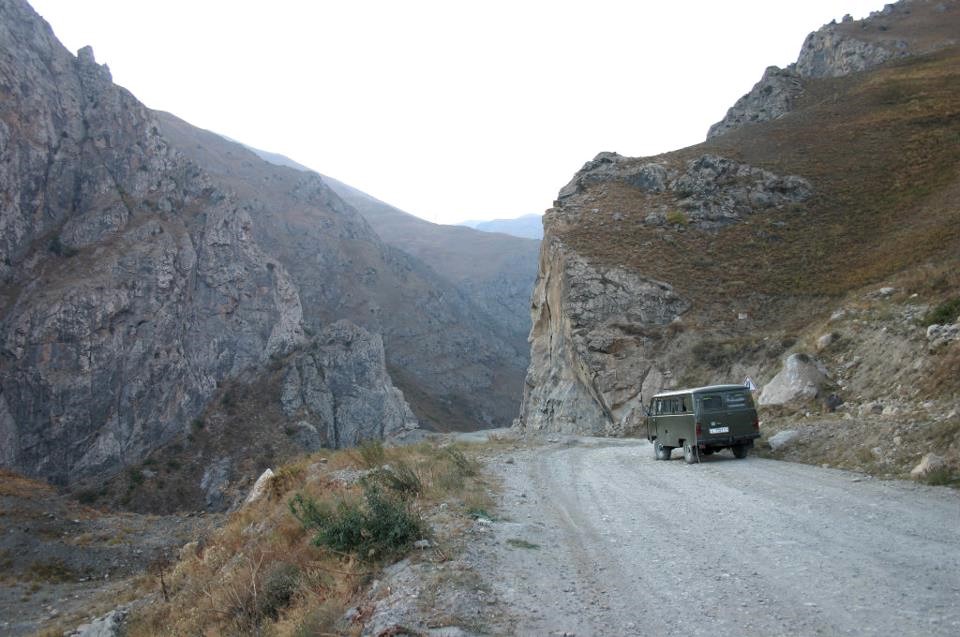
Gorno-Badakhshan, Tajikistan – 2006
Eleven years ago – that is when my interest in DNA and genetic genealogy began. Only 24 years of age then, I had been traveling within Tajikistan for roughly three weeks. I first explored the capital city of Dushanbe as a member of a Habitat for Humanity International Global Village team. Afterwards I took off to an even more far-flung corner of the country in the Gorno-Badakhshan region to check out the Pamirs and Wakhan Valley. Undoubtedly, my travels there remain steady in my top 3 favorite journeys of all time. There are many reasons and one of them is due to a very chance encounter with the group that would accelerate my desire to participate in DNA testing.
I had been wandering the bus station with my then guide, Theodore Kaye, (now an amazing editorial and corporate photographer) looking for a safe, not too tightly packed, vehicle that could get me back into Dushanbe safely. The ride back from Khorogh would be a journey of 16 hours along a very jagged path down the mountains. Selecting a vehicle that appeared to have my ultimate safety at heart was paramount. Then it happened. My face turned and caught sight of a foreigner like myself. We made eye-contact and proceeded with introductions, answering the why on Earth are you here questions and so forth. As it turned out the friendly foreigner, David Evans, a photographer for National Geographic, had been traveling in country with Dr. Spencer Wells’ team from the National Geographic Genographic project. They had just wrapped up collecting DNA samples from natives of the region. Teo asked them if it would be alright if I hitched a ride with them back to Dushanbe and they agreed.
From that point onward it was full-throttle drinking of the DNA juice that would lead me to take my very first DNA test. To be clear, the Nat Geo gang explained the Genographic project for sometime during our ride back to the capitol and I was in awe. Having never been very inclined towards science I was also a bit intimidated by Dr. Spencer Wells, but everyone was so down to Earth and the pitch they made as to why anyone and everyone should participate reeled me right on in.
Naturally, the first test I took when I returned home in late 2006 was the Genographic test.
Tampa & Sarasota, FL 2007-Present
Before proceeding any further with the details of my Genographic test results from 11 years back, testing done at additional testing companies and so on, it would be best for me to describe my initial objective and later how I’ve since evolved.
Back to Africa. That’s it. That’s all. I wanted to know where in Africa my family, the descendants of enslaved people from Africa, had arrived from when they were yanked and tugged off slave ships into the Americas. Having started my genealogical research back in 2001 my paper-trail research wasn’t answering the where in Africa question nor fulfilling my long burning desire to reconnect with brothers and sisters from the motherland. Never mind you I am very clearly the descendant of African individuals who mixed, intermingled and were likely forced into having sexual relationships with individuals of European descent. Didn’t care. Didn’t want to know. I understood the shame felt by my ancestors never wanting to talk about it. I wished first and foremost to know about my African heritage.
For the first year or two it is safe to say I was wildly naïve about what I would uncover regarding the homelands of my African ancestors.
Here is the result of my first test experience with the Genographic project.
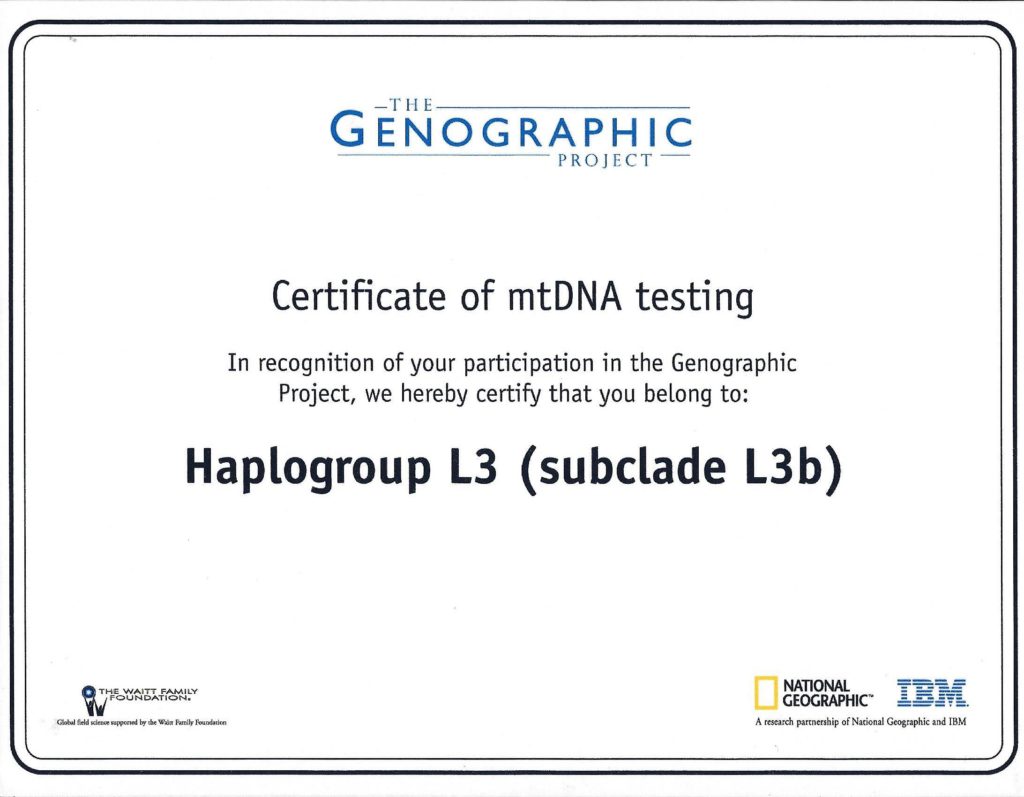
Once I sent my kit back to National Geographic in 2006 I waited roughly 6-8 weeks for my results which I received sometime in January 2007. Accompanying this dandy little certificate was an explanation of my Mitochondrial HVR I sequence, the genetic history of my branch (L3) on the human family tree, the story of Mitochondrial Eve and so on. In summary this test was telling me something I already knew: My direct maternal line originates in Africa. Now I’ve met several African American women who were surprised to learn that their direct maternal line was something other than one from haplogroup L, but not me. My mama’s mama’s mama’s, mama and them from Africa.
Still hungry to pinpoint an exact location and still very much naïve I decided to splurge and take the mtDNA or MatriClan test with African Ancestry in mid-2007. Here are a few of the items I received with that result:
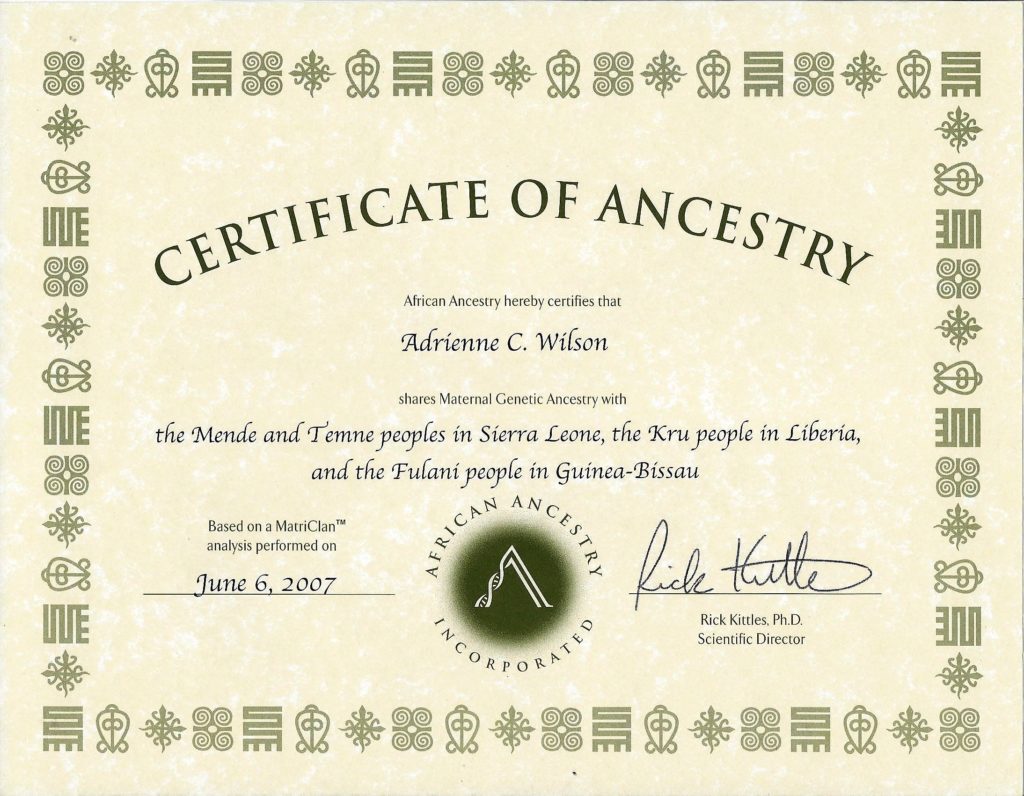
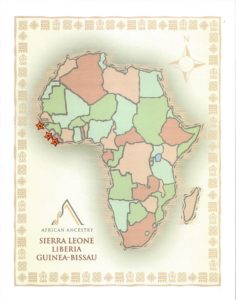 Initially, I was both pumped and confused. Their test result definitely narrowed down the result of my maternal line, but it still left me with four different groups of people from three different West African nations. From a cultural view point the Fulani of Guinea-Bissau are likely, most certainly culturally different than the Kru of Liberia or the Mende and Temme people of Sierra Leone. Which country would I travel to in search of my roots first? I read the included African Ancestry Guide to West and Central Africa from front to back. Then I realized I had oversimplified the story of my genome. The MatriClan test was only going to capture the origins of my direct maternal ancestry, but what about my mother’s paternal line or my father’s maternal line and so forth?
Initially, I was both pumped and confused. Their test result definitely narrowed down the result of my maternal line, but it still left me with four different groups of people from three different West African nations. From a cultural view point the Fulani of Guinea-Bissau are likely, most certainly culturally different than the Kru of Liberia or the Mende and Temme people of Sierra Leone. Which country would I travel to in search of my roots first? I read the included African Ancestry Guide to West and Central Africa from front to back. Then I realized I had oversimplified the story of my genome. The MatriClan test was only going to capture the origins of my direct maternal ancestry, but what about my mother’s paternal line or my father’s maternal line and so forth?
I soon realized I was in for an expensive endeavor if I wanted to get all those questions answered.
Three years later in 2010 I would have my father to take both the MatriClan and PatriClan test with African Ancestry. His results were both exciting and dispiriting. His maternal line was said to share genetic ancestry with the Tikar people living in Cameroon. However, the certificate and explanation for his direct paternal line or Y line was simply broad and crushing. That Y certificate stated that my father shares paternal genetic ancestry with people living in Spain, Portugal, Netherlands and Britain. This means my father’s father’s father’s direct paternal line goes back to a European male. No African Ancestry there, but then where in Europe exactly? Again, African Ancestry provided me with four very different countries, no haplogroup, no genetic matches to provide leads and all for a pretty hefty price.
By this point I was starting to come to the conclusion that I should just accept greater West Africa as the recent homeland of my African ancestors and set aside any aspirations of narrowing it down to the exact village. For one, my pocketbook couldn’t afford to keep testing with African Ancestry. Then there was the issue of finding cousins with direct Y and maternal lines relevant to my ancestry. If anything I appreciate African Ancestry’s services and the initial buzz of reconnecting to the continent although it is limited. So I took a brief pause before my next testing opportunity.
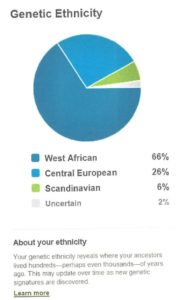
My Ancestry DNA admixture circa 2012
Come 2011 my genetic genealogy endeavor would finally begin picking up some serious steam. In November 2011, Ancestry.com offered several members of their site autosomal DNA tests at a price point that was too irresistible to turn down. I paid the $9.95 promotional rate for the test kit and received my results in May 2012. It was the longest wait of my life.
With the introduction of autosomal DNA testing I began to shift my initial research objective significantly. Simply stated, an autosomal DNA test will provide insight regarding the entire ethnicity/admixture of the test taker and on many sites will provide the test takers with genetic matches within the database that are related as closely as immediate family to more distant 5th-8th cousins. With autosomal DNA testing it matters not if you are a man or woman, either way the test taker will gain some insight about the DNA they inherited from both of their parents.

My Current Ancestry DNA Admixture Break Down
As an early test taker in Ancestry’s DNA database it has been an interesting ride. Having had to come to the conclusion that my African ancestry is attributed to ancestors from a handful of West African nations and ethnic groups, I finally decided to expand my horizons and embrace the exploration of my entire genome. Who were those European folks I came from? Better, who are all these “cousins” with European ancestry in my DNA results list? Additionally, communicating with these mysterious newfound 4th-6th cousins made me go back and analyze my paper-trail genealogy even more so.
There were a couple of new takeaways at this time: 1. I had been overshooting my homeland and that place in which I should be returning and visiting. That place is Mississippi. My pedigree on both sides of my family reflect at minimum 3-5 generations of roots in the great Magnolia State. 2. The power of discovering more about my family is in connecting with as many of my genetic cousin matches to me as humanly possible. While DNA matches with a recent direct connection to Africa are not many, when they do show up in my results list it is an opportunity to gain insight about possible family origins through their family histories. However, an exchange like this can only occur if matches correspond and quite often there is lack of response which brings on frustration.
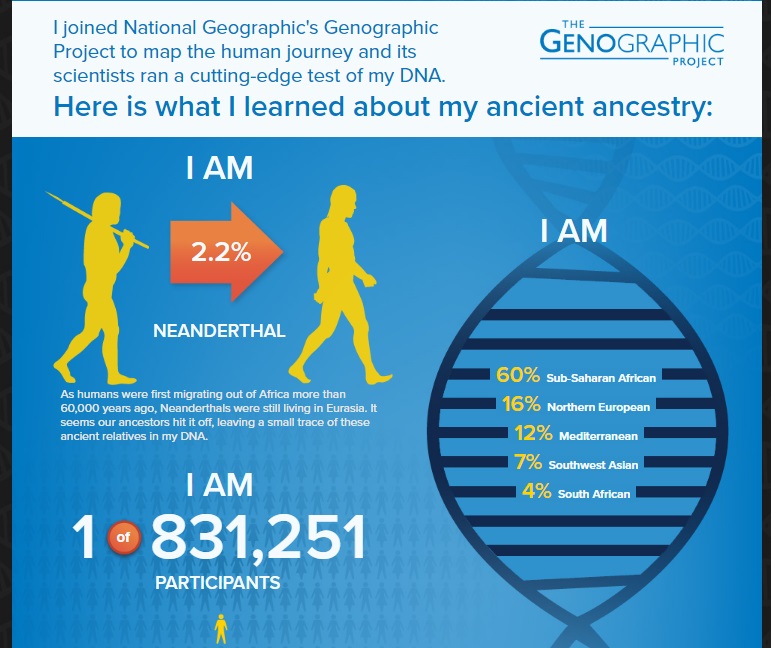
Portion of Geno 2.0 results.
Slowly, I also began to learn that autosomal DNA testing is sort of a team sport. Success comes when several many individuals in the family are willing to test. I have been lucky in this area. Since I first took my test in 2011 I have also tested my parents, three maternal aunts, one maternal uncle, two maternal half-siblings and some other maternal and paternal cousins in the 2nd-4th cousin range.
Here’s a glimpse of my DNA testing timeline of tests taken by me and my (known) family:
2006 – Tested with National Geographic Genographic project
2007 – Tested mtDNA with African Ancestry
2010 – Tested mtDNA and Y of father with African Ancestry
2011 – Tested with Ancestry DNA (me)
2012 – Tested mother and maternal half-brother on Ancestry DNA
2012 – Tested Y DNA of maternal uncle with African Ancestry
2012 – Tested again with National Geographic Genographic with updated Geno 2.0 kit and transferred mt data to Family Tree DNA
2013 – Tested Y DNA of maternal uncle and a maternal half 1st cousin 1x removed with Family Tree DNA (Y-67 markers)
2013 – Tested maternal aunt
2014 – Tested maternal aunt
2014 – Tested full maternal sequence with Family Tree DNA (my mtDNA: HVRI HVRII and Coding Region)

One of the DNA features available on 23andme if a parent and child both test.
My testing timeline is a little foggy when it comes to my 23andme experience, but I do know that my husband, my mom and myself all tested with 23andme before the FDA stepped in and halted their operation momentarily in 2013. My in-laws and two children tested very shortly after 23andme resumed testing the ancestry portion only and they have since received health information. Additionally, I did not include some 2nd cousins, half great-aunt and a few others I sought out to test because it simply gets hard to follow. I think you get the picture – that I’ve invested a good chunk of time (as well as $$$) in getting additional relatives tested. That is what it takes to be successful in making sense of the cousin connections in the various databases.
One unexpected outcome of having so many members of my family tested is having been able to use DNA as a source of proof to get me and my brother into lineage societies. In my case, I needed the DNA of my maternal uncle and our maternal 1/2 1st cousin 1x removed. While some people might argue that the affidavits I provided with my application for one society should have been well enough, I am pleased to offer my genetic findings with my paper trail search when necessary. As far as I am concerned, with DNA analysis involved, any application for any lineage society should prove to be more thorough than those without. Maybe I am just tooting my own horn, but this has opened a door that was once locked and sealed off with no other way in. You can read a little about my application for a lineage society here.
So what’s my end game? There is none. This thing will continue to go on and on like the beautiful Song That Never Ends, but in a much more magical life-fulfilling sense. I will continue to follow the many, many wonderful genetic genealogy blogs out there to stay current on DNA utility services and advancements across the various testing companies. I will only spend a limited amount of time chatting and entertaining chatter about my admixture. That’s something I expect to be refined over and over throughout this process and at best it is coffee table talk for me. Sure, I will try to withhold myself the next time I meet a Tikar individual from Cameroon. I will do my best to refrain from squeezing them in the tight embrace of our possible shared genetic kinship.
Instead I will continue to work dutifully to reconstruct the histories of my ancestors who were forcefully separated from mother and child, sister and brother or husband and wife. I will attempt to help my adopted kin to find their families, to know that they too matter. That is the power in all of this. If communities are comprised of several sets of families and many years ago those families were broken apart leaving the community severed both then and now… Doesn’t this present a wonderful opportunity to try to stitch those communities back together? If only for history’s sake? That is what I am trying to reconcile through my DNA journey.

Congratulations on a very beautifully constructed story of Your Family. It is touching.
Pingback: Favorite Reads of the Month – March 2017 – Family Locket